A Little Known Planet, Part 2
Air Date: Week of December 12, 2003
Nine years ago, the National Science Foundation launched a grant program to help pull the basic science of species identification out of the scientific backwaters. The initiative funds graduate students in particularly hard hit fields of taxonomy. Living on Earth’s Diane Toomey tagged along with one such student and her professor.
Transcript
CURWOOD: Welcome back to Living on Earth’s special “A Little Known Planet.” I'm Steve Curwood. It's probably easy to find a lot of 4th graders who say they'd like to study chimpanzees or whales or elephants when they grow up. But what 4th grader goes around saying I want to be a sea slug taxonomist? But sea slugs, along with parasitic wasps, bark beetles and many other organisms, are among the many understudied creatures that make up a critical part of ecosystems. In 1994, the National Science Foundation launched a grant program to help pull the basic science of species identification out of the scientific backwaters. The initiative funds graduate students in particularly hard hit fields of taxonomy.
Living on Earth’s Diane Toomey visited with one such student and her professor.
SIDDAL: Now talk to me. What's going to be convenient for you guys out there? Buckets?
BORDA: Tubes.
[TUBES CLINKING TOGETHER]
TOOMEY: Researcher Mark Siddall stands on the shore of a small pond on the campus of the University of Connecticut in Storrs, handing out equipment to his assistants.
SIDDALL: These are 50mL falcon tubes normally used for centrifuging various compounds. We of course use them for collecting leeches.
TOOMEY: Blood- sucking leeches are the focus of much of Mark Siddall's work. He's a curator at the American Museum of Natural History in New York City. While most people might go out of their way to avoid leeches, he goes out of his to find them. Siddall has looked for them from the jungles of Madagascar to the mountains of the Andes. Today, he's searching in western Connecticut. And after making sure her waders are properly secured, he sends his 27 year-old his graduate student, Liz Borda, into the chilly waters.
[WATER SLOSHING]
SIDDALL: All right kids. Get outta here!
BORDA: Alright.
SIDDALL: Go out and find some leeches!
BORDA: Yes, Pappa Leech.
[SOUNDS OF WADING, SPLASHING]
TOOMEY: Now that we’re out here, describe what happens next.
BORDA: So, we're just gonna stand around here, move our legs, shake our legs, hopefully not fall in. They'll be attracted to movement, so they’ll come swimming towards us. So we'll just stand around and wait.
[WATER SLOSHING]
TOOMEY: The mission today - find the New England medicinal leech, which hasn't been seen since the 1970s. The word medicinal is a leftover from blood–letting days. And although leech anticoagulants are put to use in modern medicine, during procedures such as limb attachments, that’s not why this team is interested in them. They’re motivated by simple scientific curiosity. They want to find out if the New England medicinal leech is really a distinct species and if it’s gone extinct.
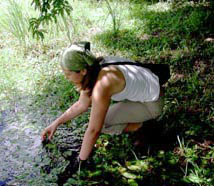
Liz Borda searches for leeches in Madagascar. (Photo: Mark Siddall)
[WATER SLOSHING]
TOOMEY: Liz brings the tiny, brown creature wriggling on the palm of her hand to Dr. Siddall to identify.
SIDDALL: Helibdelastagnalis. It might be surprising that with a naked eye I can identify a species of leech that’s maybe 4 millimeters long.
TOOMEY: I'm impressed.
SIDDALL: But if you look carefully in the light there's a tiny black dot on the neck, well, not really a neck, and that's the only species in North America that has that.
TOOMEY: Mark Siddall is one of only a handful of leech taxonomists in the world. He’s obviously devoted to the study of his creature – he even keeps a Leech Man action figure on display in his office. That's why he wants to pass on his knowledge and, as he puts it, replace himself. But his is an uphill battle.
SIDDALL: I have trouble getting scientists excited about leech systematics. I mean, let’s be honest. If you put me in a room next to Ed Wilson, who works on ants, people get excited about ants. But leeches, it’s like oooooh.
TOOMEY: And that was Liz Borda's reaction when she first encountered leeches on a trip to Madagascar to study lemurs. One day, while she was out on a hike…
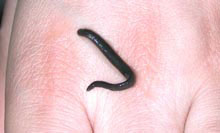
Freshwater leech of Madagascar. (Photo: Mark Siddall)
TOOMEY: But somehow, when she interviewed for a job as an assistant in Siddall's lab, she resisted the urge to run out the door when he told her what he did for a living. But because of the chance to participate in his field work, Liz says she eventually decided to follow in Dr. Siddall’s footsteps.
BORDA: Ok, maybe it’s not the cute and fuzzy animals I wanted to study but maybe this could be something different.
TOOMEY: And for the brave few like Liz, there’s a lot more leeches to find. For instance, Mark Siddall says in one six-week trip to Madagascar, he doubled the known number of terrestrial leech species on that island.
[WATER SPLASHING AND BIRDS CAWING]
TOOMEY: But no such luck today. The team has struck out at another pond, this one in nearby Massachusetts.
SIDDALL: This is a sad day. This has been the third time I’ve been here, looking for this leech, but I can't keep justifying coming back to same place.
TOOMEY: Why do you care about finding this guy, the New England medicinal leech?
SIDDALL: Oh, wow. I guess my first answer would be somewhat flippant. Why not? Academically speaking, it would be interesting to know if this species is a valid species, and that would lead us to try and understand why it’s why it's so rare. As far as understanding something that would be of benefit to humanity, that's really not my concern. I'm not bothered by that. But then neither was the person who first described the giant Amazonian leech, in the 1800s I think or the early 1900s. Nobody cared. But now we know that species has an incredibly powerful anti-coagulant that will actively break down clots after they’ve formed. Now, if no one had bothered to give that species a name and identify where it occurs and where it lives, would have bothered to look for it later to see if it had some of these properties? So my job is on the descriptive side of things. What's out there? Where are they? How are they related? I'll leave it for someone more qualified than me to figure out why that might be interesting.
[WATER SLOSHING, BIRD CAWING]
TOOMEY: Mark Siddall looks down into the chilly water, and as he continues, I hear the passion in his voice.
SIDDALL: You know, the world would be a darker, more lonely place without them. If all we had were antelope, and elephants, and panda bears, the world would be a pretty boring place. The fullness of biodiversity itself is something that's aesthetically beautiful.
[WATER SLOSHING, BIRD CAWING]
TOOMEY: Liz Borda says when she finishes her PhD in a few years, she hopes a museum, or the like, will want to employ a leech taxonomist. In the meantime, just studying leeches has its benefits.
BORDA: Honestly, saying you work on leeches can either be a conversation starter or conversation stopper. So you can use it to your advantage at times I think. [LAUGHTER]
TOOMEY: It kind of weeds out the men from the boys?
BORDA: Exactly [LAUGHS].
TOOMEY: If Liz ever discovers a new leech species, scientific protocol dictates she’ll get the honor of naming it. That’s something E.O. Wilson has had plenty of experience doing. Just for this latest book, he had to come up with more than three hundred names for the new species of pheidole ants he discovered. They include Pheidole harlequina, named for it's multicolored body, Pheidole harrisonfordi, named in honor of the actor, for his support of conservation causes, and Pheidole bison, alluding to the massive humped back of that species’ soldier ant. After studying this group for almost two decades, I asked Dr. Wilson if he had any favorites. He tells me about a rare species that has a rather unusual way of protecting its nests.
WILSON: They have heads shaped like the cork of a wine bottle and the front of the head is heavily armored like an old Greek shield. And what they do when enemies appear is they then plug the nest with their heads. And I think, to use the current word, that's kind of cool.
TOOMEY: And cool, Dr. Wilson says, will help to lure people to the study of the natural world. And if that deadline of finding all the unknown species in 25 years is to be met, people without scientific training will also need to get involved. There's one place in the U.S. where so-called citizen scientists are already being put to the test.
[CROWD NOISE, COUNTRY MUSIC]
TOOMEY: The visitor’s center at the Great Smokey Mountains National Park is hopping today. In the autumn, tourists come to this park, which straddles the border between North Carolina and Tennessee, to take in stunning foliage. And then they hit the gift shop for post cards, patches, and pumpkin butter.
[CROWD NOISE, COUNTRY MUSIC]
MALE: Thank you. Have a good day.
TOOMEY: But just a few short miles from this racket, two citizen scientists labor in quiet determination.
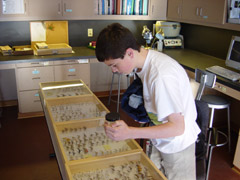
Alex Cassella identifies moths at a research facility in the Great Smokey Mountains National Park. (Photo: Jonathan Mays)
P.CASSELLA: You need an opinion?
A. CASSELLA: Is that possible? Do we possibly have him?
P. CASSELLA: I think, maybe.
A. CASSELLA: Could it be a color variation? Or is it….
TOOMEY: 14-year-old Alex Cassella and his mother Paige are combing field guides at a research facility in the park. With the help of park ranger Jonathan Mays, they’re comparing pictures of brown moths to the actual brown moth in front of them.
MAYS: He has a margin on the rear of its forewing. Let’s check in the Quebec book.
A. CASSELLA: God, the one that’s all in French?
TOOMEY: Twice a month, Alex and his mom come to the park to empty a moth trap, a Rube Goldberg contraption that uses a black light to lure the moths into a refrigerator. And then they try to figure out what's been caught. Alex, a teenager with a mature demeanor and a direct gaze, is home-schooled. But here in the Smokies, he studies under the guidance of park employees. And he’s gotten to the point where he can identify a number of moths down to the species level.
A. CASSELLA: Well, you can tell by the wing shape here, how his wings are folded back here that he’s a noctuid. You can see he has a pattern that’s very distinct. He’s got a light spot here, then a dark spot with a tiny spot of pure white in it. Like a reverse eye.
TOOMEY: In his small way, Alex is helping to complete a large project – the All Taxa Biodiversity Inventory. That's the name of the park's five year old effort to find and identify every life form within its half-million acres – bears to bacteria. It's the first project of its kind in the U.S. The mission has already discovered more than four hundred species, including beetles, millipedes, fungi, crayfish and slime molds. Alex hasn't found any new moth species – yet – but says he’s glad to help out and he’s learned a lot.
A. CASSELLA: I didn’t think there’d be nearly as many moths as there were - nondescript LBMs – little brown moths.
TOOMEY: The survey has a shoestring budget, supported mostly by two non-profit organizations. So in the summer months, armies of volunteers descend on the Smokies for activities with names like fern foray and beetle blitz. Keith Langdon is the supervisory biologist at the park and coordinates the inventory. He says the involvement of citizen scientists is essential, but it's risky.
LANGDON: What we found out hard way is that you can’t invite citizens in and turn ‘em loose, because they need someone to show ‘em the ropes. And when you’re talking about data, that bad data is far worse then no data at all. And so it requires some supervision, some structure. So we’ve been careful to expand the volunteers to where we can provide the data to make it trustworthy.
TOOMEY: So the park has a mandatory training program to insure that specimens sent to experts for identification have accurate where and what information attached to them. Langdon says many volunteers participate once. Some are repeat citizen scientists. Only a few are hardcore.
LANGDON: The gold standard here is to find someone who just becomes enamored, almost obsessed with a particular group, and actually do become local regional experts. But it’s difficult to find people who have the time and the wherewithal to provide that.
TOOMEY: And there are bottlenecks. There’s only so many staff members to train and supervise volunteers. And while it may be relatively easy to get people out on the trails to collect the bottles of bugs caught in traps, that's just the beginning.
LANGDON: We need people to go through and sort the moths from the beetles from the flies from the ants. That’s a real bottleneck. The world authorities don’t have time to do that.
TOOMEY: Langdon says he can’t really blame citizen scientists for having their limits.
LANGDON: Let’s face it. When you come to a national park, you want to hike, you want to get out and see some of the wildlife and see some vistas.
[TREES RUSTLING, BIRDS CALLING]
BARTLES: This is the minus 70 degree freezer which we use for all kinds of samples. The top shelf of that is crammed with samples from the Smokies.
TOOMEY: Right now, the only vista that concerns zoologist Paul Bartles is the one he sees in his lab freezer.
BARTLES: We've done most of the field collecting and we have a huge backlog of doing the lab processing. It takes something like six hours of lab work for every hour in field to process that stuff.
TOOMEY: That stuff is the hundreds of baggies crammed into this freezer that are stuffed with moss, lichen or soil, which are, in turn, chuck full of tardigrades. Never heard of a tardigrade? Well, neither had I.
BARTLES: There's something crawling around. Let's see what that is. Ah. Right there. There is a tardigrade.
TOOMEY: Dr. Bartles, a professor at Warren Wilson College in Asheville, North Carolina, zeroes in on one of these microscopic creatures and then let's me have a look.
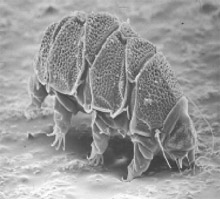 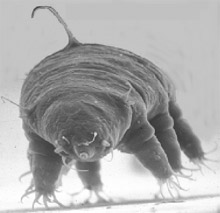 Top: armored tardigrade Bottom: non-armored tardigrade (Photo: Diane Nelson, East Tennessee State University) |
TOOMEY: It’s very cute!
BARTLES: That’s the most commonly word to describe them. TOOMEY: Under the microscope, I see a pleasantly plump creature propelling itself through the water on stubby little legs. BARTLES: If you watch for a little bit you start to see how it moves, it moves in a very mammalian like pattern. It kind of moves its head from side to side and waves its arms around. And because of that they've been called water bears. And so that’s why I call these charismatic microfauna. They’re really pretty neat little animals. TOOMEY: Paul Bartles heads up the first-ever tardigrade survey in the Smokies. So far, he and colleagues have found 44 species, 8 of which are new to science. There's probably more out there. But for now, those discoveries will have to wait because of the backlog in lab work. Before they can be sent off to one of the few specialists able to identify them, the tardigrades have to be flushed out, isolated and then placed in test tubes. With the small about of money the park has given him, Bartles has been able to hire college sophomore Stacey Hollis to do some of this grunt work, which involves lots and lots of pipetting. HOLLIS: Up and down and up and down. It takes a good while and you want to make sure to get every little bit of sediment because you don't want to miss anything. TOOMEY: It sounds like it can be tedious? HOLLIS: It can be very tedious [LAUGHS]. Sometimes I will have music playing. And it’s good to work in pairs otherwise you're just sitting there, thinking a lot. [LAUGHS] TOOMEY: Paul Bartes says it's been almost impossible to find volunteers to do this tedious work. If he had the money, he could hire a full-time technician. And he’s come up with a scheme to get that cash. Remember those eight new species of tardigrades? Well, they don’t have names yet. BARTLES: If anyone wants to donate a lot of money, I’ll name eight tardigrades after you! We can have a bidding war maybe! [LAUGHTER] [MUSIC] CURWOOD: Coming up, we’ll hear that some people don't require big bucks to do work that might seem repetitive or tedious. For them, such work is a delight. But first, In May, a group of our listeners will join me on an Eco-Tour of some of Africa’s great natural areas. The tour will include a special walking safari in South Africa’s amazing Kruger National Park. The park’s 16 ecosystems are home to over 700 species of bird and mammals. It’s a land of diversity, but Kruger is most famous for an abundance of the “Big Five”: Lions, leopards, rhinos, buffalo, and elephants. You’ll have the rare opportunity to see all these animals up close, as guides take you on day hikes and night drives. There are two ways that you can join the caravan. Go to livingonearth dot org to find out how you can win a trip for two. You can also reserve a space by buying a ticket right now. For details, visit our website – livingonearth dot org. That’s livingonearth dot org for a chance at the trip of a lifetime. [MUSIC] CURWOOD: You're listening to NPR’s Living on Earth. FEMALE ANNOUNCER: Funding for Living on Earth comes from the World Media Foundation and the Ford Foundation for reporting on U.S. environment and development issues. And the William and Flora Hewlett Foundation for coverage of Western issues. Support also comes from NPR member stations and Bob Williams and Meg Caldwell honoring NPR’s coverage of environmental and natural resource issues and in support of the NPR’s President Council. And Paul and Marsha Ginsburg, in support of excellence in public radio. Living on Earth wants to hear from you!Living on Earth Newsletter [Click here]
Donate to Living on Earth! NewsletterLiving on Earth offers a weekly delivery of the show's rundown to your mailbox. Sign up for our newsletter today!
|





